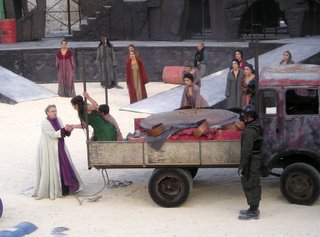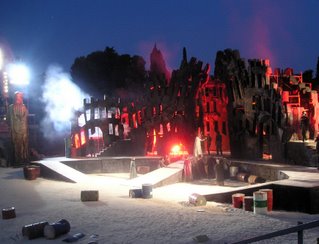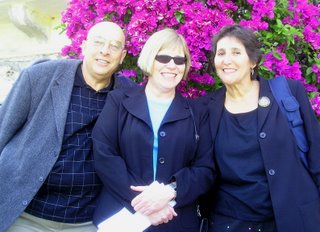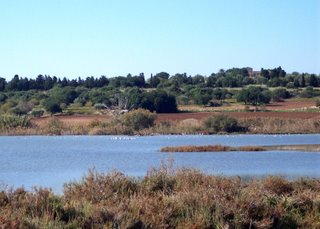Tindari: Madonnas, Mosaics, and Much More
 Tindari is a place that has it all --breathtaking scenery, Greek and Roman ruins, mosaics, the famous Black Madonna of Tindari, myths, and miracles. Driving along the autostrade from Messina to Palermo on the northeast coast of Sicily, you will see a striking church high, high on a cliff. This is the highest point of the Cape of Tindari, above the town of Patti.
Tindari is a place that has it all --breathtaking scenery, Greek and Roman ruins, mosaics, the famous Black Madonna of Tindari, myths, and miracles. Driving along the autostrade from Messina to Palermo on the northeast coast of Sicily, you will see a striking church high, high on a cliff. This is the highest point of the Cape of Tindari, above the town of Patti.The Black Madonna of Tindari is one of the many historical mysteries and the holiest icon of the island.
What I didn't realize at first was that this was not just a religious Catholic pilgrimage shrine, but also a very old and important historical site. Tindarus, as it was called, was settled during the Bronze Age (about 1500 BC). The Syracusan Greeks refounded it in 396 BC, and in 254 BC it became a Roman city. There is much to see there today, both Greek and Roman. A comparative religionist Stephen Benko points to the erection of churches housing black madonnas on the sites of former temples to Cybele, as is this one in Tindari.
 Anyone who knows me knows that I have "a thing" for madonnas and mosaics. So, I was ecstatic to find both at Tindari in the Sanctuary of the Tyndaris Madonna. The church itself was built in the past century and is a beautiful stone structure decorated inside with rich mosaics. Its whole purpose, however, is to house the Black Madonna, which is very old and of unknown origin.
Anyone who knows me knows that I have "a thing" for madonnas and mosaics. So, I was ecstatic to find both at Tindari in the Sanctuary of the Tyndaris Madonna. The church itself was built in the past century and is a beautiful stone structure decorated inside with rich mosaics. Its whole purpose, however, is to house the Black Madonna, which is very old and of unknown origin.Some say the dark wooden statue was sculpted by St. Luke himself, and that it washed ashore in a small casket, perhaps as early as the 7th century. Others say that she originated in ancient Byzantium and "legend tells that a group of fishermen found it after it fell off a ship bound from the Orient, and handed it over to the local monks. These monks built a sanctuary for it."
The most famous legend says "that once a pilgrim was most disappointed on seeing the Black Madonna and made some disparaging remarks. A short time later the child of the impertinent pilgrim fell over the cliffs. As proof of her mercy and also of her power the Madonna caused the sea to recede and soft cushions of sand to form and catch the child as it fell. It is then that she is supposed to have said 'Niger sum, sed formosa.' (I am black and beautiful.) Since then, Tindari has sat in state above the Mare Secco, the 'dry sea'." Statues of two women, justice and equality, stand near her.
It is indeed the Black Madonna that draws most of the Italian visitors to Tindari, but I discovered that there is much, much more. Beyond the church and the gorgeous clifftop views of restaurants, beyond the tiny town, you will find an amazing Roman-Greek archaeological site with yet another Greek theater and the remains of a very large building called a basilica like I have never seen before in Sicily. This Roman basilica, though, was a "public meeting house," not a temple or church . It straddles the main road, so archaeologists think it may have been a huge gateway into the main square of the city. Four arches still remain, although there were five originally. It is definitely cool to look right through the remains and see the modern church with the Black Madonna in the distance. All around are extensive remains and ongoing excavations of this Roman city that contained a forum, baths, houses, and taverns.

It is humbling to think that this place, alive today with tourists, souvenir shops, and buses, has been a special place to so many different people for thousands and thousands of years. What Goethe once said about Sicily is true: "a marvelous place . . . where many rays of Universal History converge."

It is humbling to think that this place, alive today with tourists, souvenir shops, and buses, has been a special place to so many different people for thousands and thousands of years. What Goethe once said about Sicily is true: "a marvelous place . . . where many rays of Universal History converge."
Labels: black madonna, Greek theater, madonna, mosaics, Patti, Sicily, Tindari







